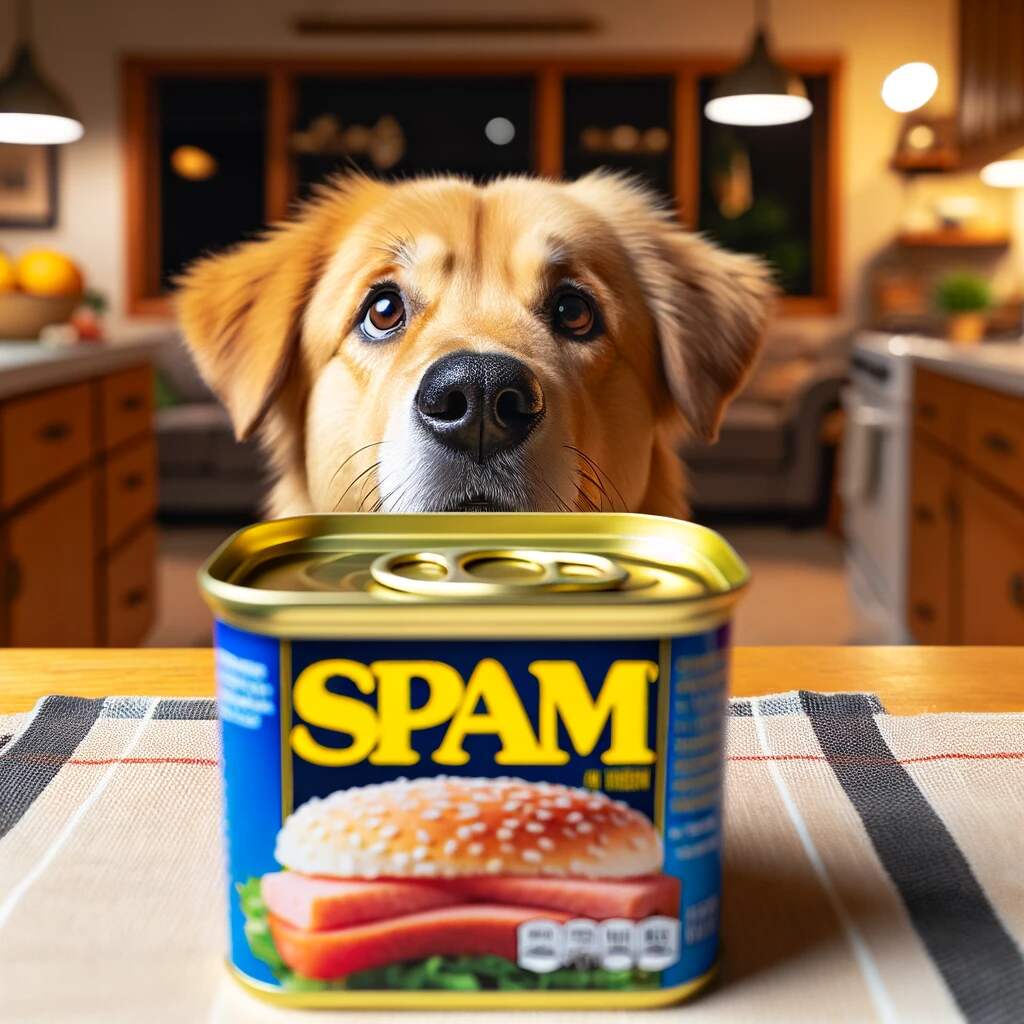Physical Address
304 North Cardinal St.
Dorchester Center, MA 02124
Physical Address
304 North Cardinal St.
Dorchester Center, MA 02124


As a responsible dog owner, you’re likely familiar with the careful consideration required when it comes to your canine companion’s diet. While dogs primarily thrive on high-quality dog food, fruits, and vegetables, there are moments when you might wonder if it’s safe to share some human food with your furry friend. One such question that often arises is whether dogs can safely consume Spam, the popular canned meat product. Is it a treat or a threat to your dog?
No, dogs should not eat Spam. While pork itself is not toxic to dogs, Spam contains high levels of sodium and fat, along with preservatives, additives, and potentially harmful spices like garlic and onion. Feeding Spam to your dog can lead to digestive issues, obesity, and even salt toxicity. It’s best to prioritize your dog’s health and offer safer, dog-friendly treats and foods instead.
Let’s examine the nutritional aspects of Spam, and explore whether it’s a safe choice for your dog.
Before we directly address whether dogs can eat Spam, it’s essential to establish a solid foundation in understanding canine nutrition. Dogs, much like humans, require a well-balanced diet consisting of protein, carbohydrates, fats, vitamins, and minerals to maintain optimal health.
Protein is vital for muscle development and overall growth, while carbohydrates provide essential energy, and fats contribute to maintaining a healthy skin and coat. Commercial dog foods are specially formulated to meet these nutritional requirements, providing a convenient and reliable option for feeding your dog. However, the occasional desire to share human food with your four-legged companion leads us to scrutinize products like Spam.
Spam is a canned meat product that has been a pantry staple in many households since its introduction by the Hormel Foods Corporation in 1937. It is primarily composed of pork shoulder meat, ham, salt, water, sugar, and a blend of spices, making it known for its long shelf life and versatility in various recipes.
The question of whether dogs can eat Spam isn’t a straightforward “yes” or “no.” To determine its safety, we must delve deeper into its nutritional composition and potential consequences for canine consumption.
1. High Sodium Content: One of the primary concerns associated with feeding Spam to dogs is its notably high sodium content. Sodium, derived from salt, is a crucial mineral for bodily functions; however, excessive salt intake can be detrimental to dogs. The elevated sodium levels in Spam can lead to increased thirst, excessive urination, and the risk of salt toxicity, resulting in symptoms like vomiting, diarrhea, seizures, and, in severe cases, even death.
2. High Fat Content: Spam contains a significant amount of fat. While fat is an essential component of a dog’s diet, excessive fat intake can lead to obesity and digestive issues. Some dogs may find it challenging to digest the high-fat content in Spam, potentially resulting in gastrointestinal problems such as diarrhea and pancreatitis.
3. Processed Ingredients: Spam is a processed meat product that may contain additives, preservatives, and flavor enhancers. These components may not be ideal for canine consumption, raising concerns about potential adverse reactions in dogs.
4. Added Sugars and Spices: Ingredients such as sugar and spices, including garlic and onion, are commonly found in Spam. These ingredients may not be well-tolerated by dogs, and some, like garlic and onion, can be toxic to them, leading to digestive disturbances or more severe health issues.
5. Potential Allergies: Dogs, like humans, can have food allergies or sensitivities. Certain dogs may be allergic to specific ingredients in Spam, potentially causing allergic reactions such as itching, skin problems, or gastrointestinal distress.
Feeding Spam to your dog carries several potential risks:
While it is technically possible to share a small amount of Spam with your dog as an occasional treat, it is not a recommended or healthy choice. If you decide to do so, moderation is paramount:
If you seek safer and healthier alternatives to Spam as a dog treat, consider the following options:
In conclusion, can dogs eat spam? While it is technically possible to feed your dog Spam in small amounts, it is not a recommended or healthy choice. Spam’s high sodium and fat content, coupled with potential allergens and additives, make it a suboptimal choice for canine consumption. Prioritizing your dog’s health and well-being is crucial by providing them with a balanced diet of high-quality commercial dog food and offering safer and healthier treats in moderation.
Before introducing any new food into your dog’s diet, it is advisable to consult with your veterinarian to ensure it is safe and suitable for your specific dog’s needs. Each dog is unique, and what may be safe for one could be harmful to another. Ultimately, the health and safety of your dog should always be the top priority when considering their diet and nutrition.”